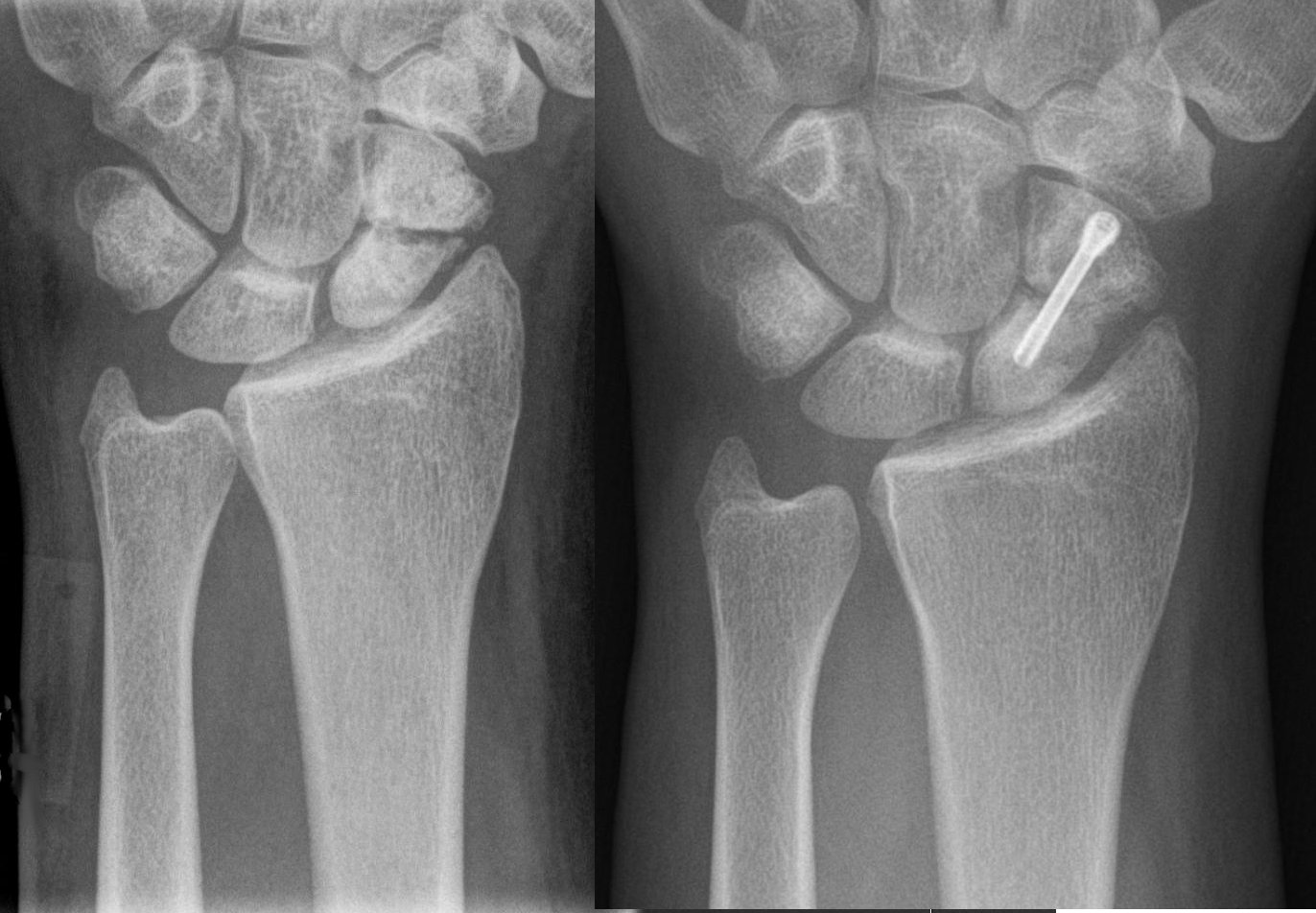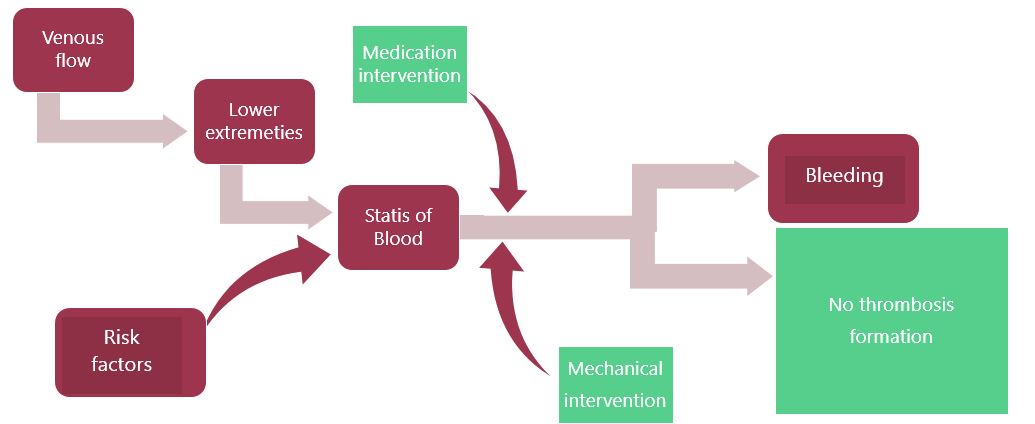|
Hip Fracture
A hip fracture is a break that occurs in the upper part of the femur (thigh bone). Symptoms may include pain around the hip, particularly with movement, and shortening of the leg. Usually the person cannot walk. They most often occur as a result of a fall. (Femoral head fractures are a rare kind of hip fracture that may also be the result of a fall but are more commonly caused by more violent incidents such as traffic accidents.) Risk factors include osteoporosis, taking many medications, alcohol use, and metastatic cancer. Diagnosis is generally by X-rays. Magnetic resonance imaging, a CT scan, or a bone scan may occasionally be required to make the diagnosis. Pain management may involve opioids or a nerve block. If the person's health allows, surgery is generally recommended within two days. Options for surgery may include a total hip replacement or stabilizing the fracture with screws. Treatment to prevent blood clots following surgery is recommended. About 15% of wo ... [...More Info...] [...Related Items...] OR: [Wikipedia] [Google] [Baidu] |
Femoral Fracture
A femoral fracture is a bone fracture that involves the femur. They are typically sustained in high-impact trauma, such as car crashes, due to the large amount of force needed to break the bone. Fractures of the diaphysis, or middle of the femur, are managed differently from those at the head, neck, and trochanter. Signs and symptoms Fractures are commonly obvious, since femoral fractures are often caused by high energy trauma. Signs of fracture include swelling, deformity, and shortening of the leg. Extensive soft-tissue injury, bleeding, and shock are common. The most common symptom is severe pain, which prevents movement of the leg. Diagnosis Physical exam Femoral shaft fractures occur during extensive trauma, and they can act as distracting injuries, whereby the observer accidentally overlooks other injuries, preventing a thorough exam of the complete body. For example, the ligaments and meniscus of the ipsilateral (same side) knee are also commonly injured. Radio ... [...More Info...] [...Related Items...] OR: [Wikipedia] [Google] [Baidu] |
Femoral Head Fracture
Femoral head fractures are very rare fractures of the upper end (femoral head) of the thigh bone (femur). They are a very rare kind of hip fracture that may be the result of a fall like most hip fractures but are more commonly caused by more violent incidents such as traffic accidents They are categorized according to the Pipkin classification based on the following bone fracture patterns: See also *Femoral neck The femoral neck (femur neck or neck of the femur) is a flattened pyramidal process of bone, connecting the femoral head with the femoral shaft, and forming with the latter a wide angle opening medialward. Structure The neck is flattened from ... References Orthobullets Hip fracture classifications {{Orthopedics-stub ... [...More Info...] [...Related Items...] OR: [Wikipedia] [Google] [Baidu] |
Malunion
A malunion is when a fractured bone does not heal properly. Some ways that it shows is by having the bone being twisted, shorter, or bent. Malunions can occur by having the bones improperly aligned when immobilized, having the cast taken off too early, or never seeking medical treatment after the break. Malunions are painful and commonly produce swelling around the area, possible immobilization, and deterioration of the bone and tissue. Signs and symptoms Malunions are presented by excessive swelling, twisting, bending, and possibly shortening of the bone. Patients may have trouble placing weight on or near the malunion. Diagnosis An X-ray is essential for the proper diagnosis of a malunion. The doctor will look into the patient’s history and the treatment process for the bone fracture. Oftentimes a CT scan and probably an MRI are also used in diagnosis. MRI are used to check of cartilage and ligament issues that developed due to the malunion and misalignment. CT scans ... [...More Info...] [...Related Items...] OR: [Wikipedia] [Google] [Baidu] |
Avascular Necrosis
Avascular necrosis (AVN), also called osteonecrosis or bone infarction, is death of bone tissue due to interruption of the blood supply. Early on, there may be no symptoms. Gradually joint pain may develop which may limit the ability to move. Complications may include collapse of the bone or nearby joint surface. Risk factors include bone fractures, joint dislocations, alcoholism, and the use of high-dose steroids. The condition may also occur without any clear reason. The most commonly affected bone is the femur. Other relatively common sites include the upper arm bone, knee, shoulder, and ankle. Diagnosis is typically by medical imaging such as X-ray, CT scan, or MRI. Rarely biopsy may be used. Treatments may include medication, not walking on the affected leg, stretching, and surgery. Most of the time surgery is eventually required and may include core decompression, osteotomy, bone grafts, or joint replacement. About 15,000 cases occur per year in the United States. ... [...More Info...] [...Related Items...] OR: [Wikipedia] [Google] [Baidu] |
Nonunion
Nonunion is permanent failure of healing following a broken bone unless intervention (such as surgery) is performed. A fracture with nonunion generally forms a structural resemblance to a fibrous joint, and is therefore often called a "false joint" or pseudoarthrosis (from Greek ''pseudo-'', meaning false, and , meaning joint). The diagnosis is generally made when there is no healing between two sets of medical imaging, such as X-ray or CT scan. This is generally after 6–8 months.Page 542 in: Nonunion is a serious complication of a fracture and may occur when the fracture moves too much, has a poor s ... [...More Info...] [...Related Items...] OR: [Wikipedia] [Google] [Baidu] |
Knee
In humans and other primates, the knee joins the thigh with the leg and consists of two joints: one between the femur and tibia (tibiofemoral joint), and one between the femur and patella (patellofemoral joint). It is the largest joint in the human body. The knee is a modified hinge joint, which permits flexion and extension as well as slight internal and external rotation. The knee is vulnerable to injury and to the development of osteoarthritis. It is often termed a ''compound joint'' having tibiofemoral and patellofemoral components. (The fibular collateral ligament is often considered with tibiofemoral components.) Structure The knee is a modified hinge joint, a type of synovial joint, which is composed of three functional compartments: the patellofemoral articulation, consisting of the patella, or "kneecap", and the patellar groove on the front of the femur through which it slides; and the medial and lateral tibiofemoral articulations linking the femur, or thigh ... [...More Info...] [...Related Items...] OR: [Wikipedia] [Google] [Baidu] |
Groin
In human anatomy, the groin (the adjective is ''inguinal'', as in inguinal canal) is the junctional area (also known as the inguinal region) between the abdomen and the thigh on either side of the pubic bone. This is also known as the medial compartment of the thigh that consists of the adductor muscles of the hip or the groin muscles. A pulled groin muscle usually refers to a painful injury sustained by straining the hip adductor muscles. These hip adductor muscles that make up the groin consist of the adductor brevis, adductor longus, adductor magnus, gracilis, and pectineus. These groin muscles adduct the thigh (bring the femur and knee closer to the midline). The groin is innervated by the obturator nerve, with two exceptions: the pectineus muscle is innervated by the femoral nerve, and the hamstring portion of adductor magnus is innervated by the tibial nerve. In the groin, underneath the skin, there are three to five deep inguinal lymph nodes that play a role in ... [...More Info...] [...Related Items...] OR: [Wikipedia] [Google] [Baidu] |
Clinical Presentation
In a physical examination, medical examination, or clinical examination, a medical practitioner examines a patient for any possible medical signs or symptoms of a medical condition. It generally consists of a series of questions about the patient's medical history followed by an examination based on the reported symptoms. Together, the medical history and the physical examination help to determine a diagnosis and devise the treatment plan. These data then become part of the medical record. Types Routine The ''routine physical'', also known as ''general medical examination'', ''periodic health evaluation'', ''annual physical'', ''comprehensive medical exam'', ''general health check'', ''preventive health examination'', ''medical check-up'', or simply ''medical'', is a physical examination performed on an asymptomatic patient for medical screening purposes. These are normally performed by a pediatrician, family practice physician, physician assistant, a certified nurse ... [...More Info...] [...Related Items...] OR: [Wikipedia] [Google] [Baidu] |
Thrombosis Prevention
Thrombosis prevention or thromboprophylaxis is medical treatment to prevent the development of thrombosis (blood clots inside blood vessels) in those considered at risk for developing thrombosis. Some people are at a higher risk for the formation of blood clots than others, such as those with cancer undergoing a surgical procedure. Prevention measures or interventions are usually begun after surgery as the associated immobility will increase a person's risk. Blood thinners are used to prevent clots, these blood thinners have different effectiveness and safety profiles. A 2018 systematic review found 20 studies that included 9771 people with cancer. The evidence did not identify any difference between the effects of different blood thinners on death, developing a clot, or bleeding. A 2021 review found that low molecular weight heparin (LMWH) was superior to unfractionated heparin in the initial treatment of venous thromboembolism for people with cancer. There are medication-ba ... [...More Info...] [...Related Items...] OR: [Wikipedia] [Google] [Baidu] |
Total Hip Replacement
Hip replacement is a surgical procedure in which the hip joint is replaced by a prosthetic implant, that is, a hip prosthesis. Hip replacement surgery can be performed as a total replacement or a hemi (half) replacement. Such joint replacement orthopaedic surgery is generally conducted to relieve arthritis pain or in some hip fractures. A total hip replacement (total hip arthroplasty or THA) consists of replacing both the acetabulum and the femoral head while hemiarthroplasty generally only replaces the femoral head. Hip replacement is one of the most common orthopaedic operations, though patient satisfaction varies widely. Approximately 58% of total hip replacements are estimated to last 25 years. The average cost of a total hip replacement in 2012 was $40,364 in the United States, and about $7,700 to $12,000 in most European countries. Medical uses Total hip replacement is most commonly used to treat joint failure caused by osteoarthritis. Other indications include rheuma ... [...More Info...] [...Related Items...] OR: [Wikipedia] [Google] [Baidu] |
Opioids
Opioids are substances that act on opioid receptors to produce morphine-like effects. Medically they are primarily used for pain relief, including anesthesia. Other medical uses include suppression of diarrhea, replacement therapy for opioid use disorder, reversing opioid overdose, and suppressing cough. Extremely potent opioids such as carfentanil are approved only for veterinary use. Opioids are also frequently used non-medically for their euphoric effects or to prevent withdrawal. Opioids can cause death and have been used for executions in the United States. Side effects of opioids may include itchiness, sedation, nausea, respiratory depression, constipation, and euphoria. Long-term use can cause tolerance, meaning that increased doses are required to achieve the same effect, and physical dependence, meaning that abruptly discontinuing the drug leads to unpleasant withdrawal symptoms. The euphoria attracts recreational use, and frequent, escalating recreational u ... [...More Info...] [...Related Items...] OR: [Wikipedia] [Google] [Baidu] |









